 ANNOTATED BIBLIOGRAPHY
ANNOTATED BIBLIOGRAPHY
BOOKS
Beilenson, Peter. Japanese Haiku. Mount Vernon, New York: Peter Pauper Press, 1956.
Translations of famous Japanese haiku with a good introduction.
Blyth, R. H. Haiku. Vol I: Eastern Culture. Vol. II: Spring. Vol III: Summer-Autumn. Vol. IV: Autumn-Winter. Tokyo: Hokuseido, 1949-1952.
Volume I describes the spiritual origins of haiku in Buddhism, Zen and other Oriental religions; it shows how certain verses in the great English poets are haiku. A brief section gives the techniques of haiku. Volumes II to IV analyse the chief words and concepts used to denote the seasons in haiku.
_____. A History of Haiku. 2 vols. Tokyo: Hokuseido, 1963-64.
Volume I gives a comprehensive history of haiku from the beginning to Issa; volume II from Issa to the present.
_____. Zen in English Literature and Oriental Classics. Tokyo: Hokuseido, 1942.
Illustrates principles of Zen in both English and Oriental writings. Excellent insights, but of uneven value.
Bownas, Geoffrey and Thwaite, Anthony (trans.). The Penguin Book of Japanese Verse. Hammondsworth, Middlesex: Penguin, 1964.
All types of Japanese verse from primitive times to the present. The introduction gives a brief rsum of Japanese prosody.
Canby, Henry S. (ed.). The Works of Thoreau. Boston: Houghton Mifflin, 1937.
Ernst, Earle. The Kabuki Theatre. New York: Oxford University Press, 1956.
Goodman, Henry (ed.). The Selected Writings of Lafcadio Hearn. New York: Citadel Press, 1949.
Hackett, James. The Way of Haiku: An Anthology of Haiku Poems. Tokyo: Japan Publications, 1969.
Hall, J. W. and Beardsley, R. K. Twelve Doors to Japan. New York: McGraw-Hill, 1965.
Contains an excellent essay on Japanese literature by Joseph K. Yamagiwa.
Henderson, Harold G. Haiku in English. Rutland, Vermont and Tokyo, Japan: Tuttle, 1967.
A brief work written in a popular style. Contains excellent insights on English haiku.
_____. An Introduction to Haiku. Garden City, New York: Doubleday and Company, Inc., 1958.
Translations of well-known Japanese haiku, perceptive commentaries integrated with a history of haiku and an excellent appendix on Japanese particles.
Keene, Donald. Japanese Literature: An Introduction for Western Readers. New York: Grove Press, 1956.
An excellent introduction to Japanese literature which corrects false impressions of Japanese literature and language and gives an overview of the characteristics of Japanese poetry.
Los Altos Writers Roundtable. Borrowed Water: A Book of American Haiku. Rutland, Vermont and Tokyo, Japan: Tuttle, 1966.
An important experiment in writing haiku which are not Japanese but truly American, dealing with Western subjects.
Miner, Earl. The Japanese Tradition in British and American Literature. Princeton, New Jersey: Princeton University Press, 1958.
A scholarly, well-written exposition of the influence of Japan on British and American Literature from the Renaissance to Pound and Yeats. Of particular interest is the effect of the haiku on Pound's poetry.
Miyamori Asataro. An Anthology of Haiku Ancient and Modern. Tokyo: Taiseido, 1932.
Haiku in Japanese, romanized Japanese and English translation, with many explanations of individual haiku, a brief comparison of haiku and epigrams, a history of haiku and sketches of four masters of haiku.
Pei, Mario. The Story of Language. Philadelphia: Lippincott, 1949.
Contains a brief but interesting comparison of the English and Japanese languages.
Reps, Paul (comp.). Zen Flesh, Zen Bones: A Collection of Zen and Pre-Zen Writings. Rutland, Vermont and Tokyo, Japan: Tuttle, 1957.
Translations of Zen stories and anecdotes.
Rollins, Hyder and Baker, Herschel. The Renaissance in England. Boston: D. C. Heath, 1954.
Ross, Nancy Wilson (comp.). The World of Zen: An East-West Anthology. London: Collins, 1962.
Contains Zen writings and a good introduction describing Zen.
Scott, A. F. The Poet's Craft. New York: Cambridge University Press, 1957.
Smith, Bradley (ed.). Japan: A History in Art. New York: Simon & Schuster, 1964.
The relationship between Japanese art and religious belief is well explained.
Stevens, Wallace. The Collected Poems of Wallace Stevens. New York: Alfred A. Knopf, 1955.
Suzuki, D. T. An Introduction to Zen Buddhism. London: Arrow Books, 1959.
A conscientious account of Zen Buddhism particularly interesting for its explanation of satori.
Tsunoda Ryusaku, deBary, Wm. Theodore and Keene, Donald (comps.). Sources of Japanese Tradition. 2 vols. New York: Columbia University Press, 1958.
Translations of Japanese writings, chiefly of historical, religious and literary interest, with excellent essays and commentaries.
Whitehall, Harold. Structural Essentials of English. New York: Harcourt Brace Jovanovich, 1956.
Yasuda, Kenneth. The Japanese Haiku: Its Essential Nature, History, and Possibilities in English. Rutland, Vermont and Tokyo, Japan: Tuttle, 1957.
Provides an exhaustive study of the place of haiku in the world of literature.
Yuasa Nobuyuki (trans.). Basho: The Narrow Road to the Deep North and Other Travel Sketches. Hammondsworth, Middlesex: Penguin, 1966.
Basho's most important works. The settings of his most famous poems described by the poet.
ARTICLES AND ESSAYS
Asano Nagatake. "Introduction to the Art of Japan." In Smith, Bradley (ed .). Japan: A History in Art. New York: Simon & Schuster, 1964.
Jansen, Maurius B. "Introduction to the History of Japan." In Smith, Bradley (ed .). Japan: A History in Art. New York: Simon & Schuster, 1964.
Kanterman, Leroy. Haiku West. New York: By the author. Nos. 1 and. 2 (June, 1967 and January, 1968).
A "little magazine" containing haiku of all degrees of value and short articles about haiku.
Miner, Earl. "The Techniques of Japanese Poetry." In Hudson Review VIII (Autumn, 1955), 350-66.
Shows how waka illustrate the inner workings of Japanese poetic technique and the assumptions about life and poetry necessary to appreciate the peculiar accomplishment of Japanese lyric poetry.
Miyazaki Toshiko. "Haiku." 1965, handwritten.
Gives a brief history of haiku and criticisms of a few well-known haiku.
Otake Masaru. "Wallace Stevens no Shi to Haiku" [Haiku and the Poems of Wallace Stevens]. In Eigo Seinen [The Rising Generation], January 1, 1966.
Shows the haiku elements in Stevens's "Thirteen Ways of Looking at a Blackbird."
Scribner, Penny. "Haiku Poetry." In Arts and Activities: The Teacher's Arts and Crafts Guide, September, 1967.
Although the comments on haiku are rather superficial, there are good insights into haiku from the point of view of painting.
Yamagiwa, Joseph K. "Literature and Japanese Culture." In Hall, J. W. and Beardsley, R. K. (eds.). Twelve Doors to Japan. New York: McGraw-Hill, 1965.
I THE MEANING OF HAIKU
The great appeal of haiku poems seems to result mainly from two qualities: their dependence on the reader's power of awareness, bringing him closer to simple, elemental truths; and their capacity to grow in meaning as they are read and reread. Before discussing at length the background and elements of haiku, it is interesting to note briefly the origin of the form as it developed from waka, renga and renku. A short history of the growth of haiku may clarify points which follow in later chapters. An introduction to Basho, Buson, Issa and Shiki as the four undisputed masters of haiku and a description of the variation of haiku known as senryu, as well as an overview of developments in English haiku, are necessary preliminaries to any study of the form.


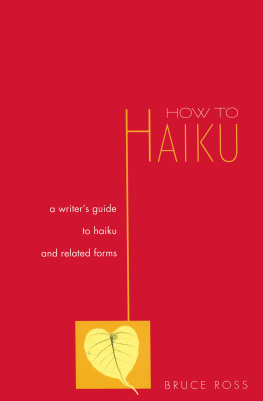

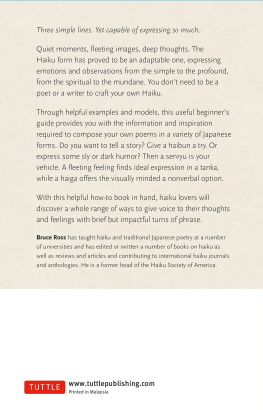
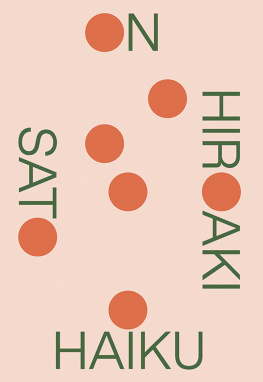
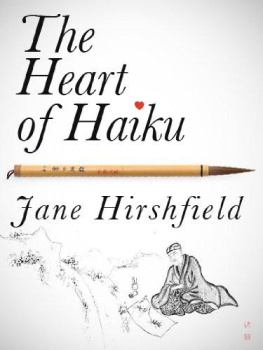

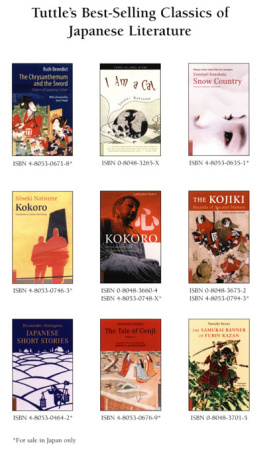

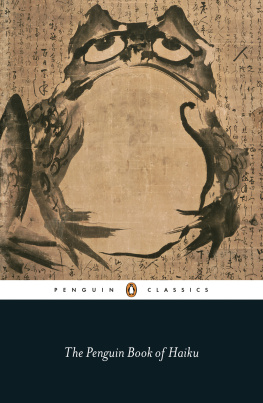
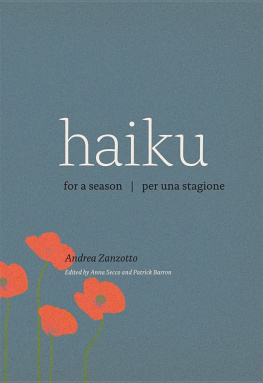
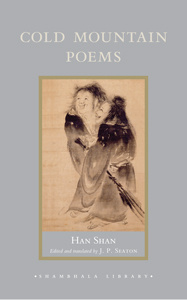

 ANNOTATED BIBLIOGRAPHY
ANNOTATED BIBLIOGRAPHY